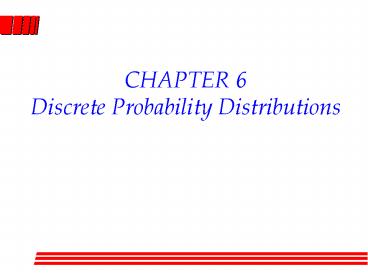CHAPTER 6 Discrete Probability Distributions - PowerPoint PPT Presentation
1 / 13
Title:
CHAPTER 6 Discrete Probability Distributions
Description:
Distinguish between discrete and continuous random variables. ... b. P(x 8) Go to Appendix, Table A.2, n = 20. For p = 0.5. and k = 8, P(x 8) = 0.2517 ... – PowerPoint PPT presentation
Number of Views:88
Avg rating:3.0/5.0
Title: CHAPTER 6 Discrete Probability Distributions
1
CHAPTER 6Discrete Probability Distributions
2
Chapter 6 - Learning Objectives
- Distinguish between discrete and continuous
random variables. - Differentiate between the binomial and the
Poisson discrete probability distributions and
their applications. - Construct a probability distribution for a
discrete random variable, determine its mean and
variance, and specify the probability that a
discrete random variable will have a given value
or value in a given range.
3
Chapter 6 - Key Terms
- Random variables
- Discrete
- Continuous
- Bernoulli process
- Probability distributions
- Binomial distribution
- Poisson distribution
4
Discrete vs Continuous Variables
- Discrete Variables Can take on only certain
values along an interval - the number of sales made in a week
- the volume of milk bought at a store
- the number of defective parts
- Continuous Variables Can take on any value at
any point along an interval - the depth at which a drilling team strikes oil
- the volume of milk produced by a cow
- the proportion of defective parts
5
Describing the Distribution for a Discrete Random
Variable
- The probability distribution for a discrete
random variable defines the probability of a
discrete value x. - Mean µ E(x)
- Variance s2 E(x µ)2
6
The Bernoulli Process, Characteristics
- There are two or more consecutive trials.
- In each trial, there are just two possible
outcomes. - The trials are statistically independent.
- The probability of success remains constant
trial-to-trial.
7
The Binomial Distribution
- The binomial probability distribution defines the
probability of exactly x successes in n trials of
the Bernoulli process. - for each value of x.
- Mean µ E(x) n p
- Variance s2 E(x µ)2 n p (1 p)
8
The Binomial Distribution,An Example Worked by
Equation
- Problem 6.23 A study by the International Coffee
Association found that 52 of the U.S. population
aged 10 and over drink coffee. For a randomly
selected group of 4 individuals, what is the
probability that 3 of them are coffee drinkers?
Number Proportion - Coffee drinkers (x) 3 .52
- Noncoffee drinkers 1 .48
- Totals 4 1.00
- So, p 0.52, (1 p) 0.48, x 3, (n x)
1 .
9
The Binomial Distribution,Working with the
Equation
- To solve the problem, we substitute
10
The Binomial Distribution,An Example Worked with
Tables
- Problem According to a corporate association,
50.0 of the population of Vermont were boating
participants during the most recent year. For a
randomly selected sample of 20 Vermont residents,
with x the number sampled who were boating
participants that year, determine - a. E(x) n p 20 x 0.50 10
- b. P(x 8) Go to Appendix, Table A.2, n 20.
For p 0.5 - and k 8, P(x 8) 0.2517
- c. P(x 10) Go to Appendix, Table A.1, n 20.
For p 0.5 - and k 10, P(x 10) 0.1762
11
Example Binomial Tables
- Problem According to a corporate association,
50.0 of the population of Vermont were boating
participants during the most recent year. For a
randomly selected sample of 20 Vermont residents,
with x the number sampled who were boating
participants that year, determine - d. P(x 12) Go to Appendix, Table A.1, n 20.
For p 0.5 - and k 12, P(x 12) 0.1201
- e. P(7 x 13) Go to Appendix, Table A.2, n
20. For p 0.5 - and k 13, P(x 13) 0.9423
- For p 0.5 and k 6, P(x 6) 0.0577
- P(7 x 13) 0.9423 0.0577 0.8846
12
Example Using Microsoft Excel
- Problem According to a corporate association,
50.0 of the population of Vermont were boating
participants during the most recent year. For a
randomly selected sample of 20 Vermont residents,
with x the number sampled who were boating
participants that year, determine - b. P(x 8) In a cell on an Excel worksheet,
type - BINOMDIST(8,20,0.5,true)
- and you will see the answer 0.2517
- c. P(x 10) In a cell on an Excel worksheet,
type - BINOMDIST(10,20,0.5,false)
- and you will see the answer 0.1762
13
Example Using Microsoft Excel
- Problem According to a corporate association,
50.0 of the population of Vermont were boating
participants during the most recent year. For a
randomly selected sample of 20 Vermont residents,
with x the number sampled who were boating
participants that year, determine - d. P(x 12) In a cell on an Excel worksheet,
type - BINOMDIST(12,20,0.5,false)
- and you will see the answer 0.1201
- e. P(7 x 13) In a cell on an Excel worksheet,
type - BINOMDIST(13,20,0.5,true)- BINOMDIST(6,20,0.5,tru
e) - and you will see the answer 0.8846































